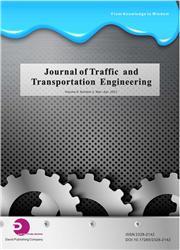Preliminary Investigation on Establishing a New Resilient Modulus Test Approach for Reduced Size Asphalt Mixture Samples Smaller Than 100 mm Diameter
引用次数: 0
Abstract
The performance evaluation of existing flexible pavements has become a priority issue for many highway maintenances engineers. To make appropriate rehabilitation and management decisions, the engineers most often rely on efficient methods for the determination of the strength of pavement layers. Resilient modulus is a very important parameter to be identified and used in pavement design. The resilient moduli of asphalt mixtures are typically measured using the indirect tension test procedure in compliance with the ASTM D4123 standard that is superseded by ASTM D7369. The standard requirement is that the prepared specimens for the tests should have a minimum height of the sample over its diameter ratio of 0.4. Generally, specimens used in the tests are either a nominal 100 mm or 150 mm in diameter with a minimum thickness over diameter ratio of 0.4. However, 100 mm diameter core specimens taken from site wearing courses with thicknesses ranging from 40 mm to 50 mm most often do not fulfil the minimum ratio of 0.4 after they are trimmed for testing. Since there was no any option, part of the binder courses had to be trimmed to make up for the minimum ratio requirement. This tends to result in inaccurate assessment of the resilient modulus values of the samples. As such, a new procedure was explored to test specimens smaller than 100 mm in diameter. This may minimize the material volume requirement from the field and also for the fabrication of smaller samples in the laboratory. Based on the available thickness of wearing course or overlay, the appropriate sizes were determined. For a two-layer system a 56.3 mm diameter was deemed necessary while a 37.5 mm diameter was observed to be appropriate for a three-layer system. Such an approach for resilient modulus test using miniature specimens of 56.3 mm and 37.5 mm in diameter has a great potential for practical relevance for the industry.粒径小于100mm沥青混合料减缩样弹性模量试验新方法的初步研究
现有柔性路面的性能评价已成为许多公路养护工程师优先考虑的问题。为了做出适当的修复和管理决策,工程师通常依靠有效的方法来确定路面层的强度。弹性模量是路面设计中需要识别和使用的重要参数。沥青混合料的弹性模量通常使用符合ASTM D4123标准的间接张力测试程序进行测量,该标准已被ASTM D7369取代。标准要求为试验准备的试样的最小高度与其直径之比应为0.4。通常,试验中使用的试样标称直径为100mm或150mm,最小厚度与直径之比为0.4。然而,从现场磨损过程中采集的厚度从40毫米到50毫米的直径为100毫米的岩心样品,在经过修整进行测试后,通常不能满足0.4的最小比率。由于没有任何选择,部分粘合剂课程必须修剪,以弥补最低比例的要求。这往往会导致对样品弹性模量值的不准确评估。因此,研究人员探索了一种新的方法来测试直径小于100毫米的样品。这可以最大限度地减少现场的材料体积需求,也可以在实验室中制造较小的样品。根据磨损层或覆盖层的可用厚度,确定合适的尺寸。对于双层系统,56.3毫米的直径被认为是必要的,而对于三层系统,37.5毫米的直径被认为是合适的。这种使用直径为56.3 mm和37.5 mm的微型试样进行弹性模量测试的方法具有很大的行业实际应用潜力。
本文章由计算机程序翻译,如有差异,请以英文原文为准。
求助全文
约1分钟内获得全文
求助全文

 求助内容:
求助内容: 应助结果提醒方式:
应助结果提醒方式:


